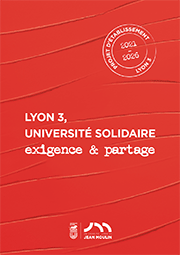AccueilRechercheProgrammes et productions scientifiquesThèsesThèses soutenuesThèses soutenues - 2006-2021Thèses soutenues - 2012
-
Partager cette page
- Recherche,
DRAGOSTIN Monica
La population de la Dacie Romaine : "étude anthroponymique et prosopographique"
Publié le 4 janvier 2013 – Mis à jour le 17 juin 2020
Thèse en Histoire religieuse, politique et culturelle soutenue le 8 octobre 2012 en cotutelle avec l'Université de Bucarest
Parmi les provinces romaines, la Dacie, par son emplacement aux confins des civilisations grecque et latine, a abrité une population cosmopolite, caractérisée par le multilinguisme et le multiculturalisme, pour laquelle le latin et le mode de vie romain ont joué un rôle de catalyseur. En l’absence des investissements coûteux dans les projets archéologiques, l’onomastique a su suppléer avec succès les résultats des fouilles, en fournissant un matériel fertile qui complète le tableau historique de la province et qui redonne une image assez fidèle de ses habitants. L’essor des études onomastiques dans l’après guerre, la transformation de l’onomastique de science auxiliaire de l’histoire en science autonome, s’est traduit en Roumanie par une série d’enquêtes qui essayent de reconstituer, au moins partiellement, des anciennes langues aujourd’hui disparues (l’illyrien, le thrace) à partir de leurs uniques vestiges : les noms propres. Suivant la tradition de l’époque, les ouvrages désormais classiques de I. I Russu ne retiennent que les aspects linguistiques, la morphologie et l’étymologie des noms, dans l’esprit des études indo-européennes qui dominaient alors l’historiographie occidentale. Dans ce sillage, les auteurs qui ont suivi, ont adopté la même perspective philologique qu’ils ont enrichie plus récemment par des études prosopographiques, mais leurs travaux restent ponctuels, limités à une certaine communauté ethnique, à une catégorie sociale ou bien à la population des grandes villes. De là naît le besoin d’un projet plus étendu qui porte sur l’ensemble de la province et qui, tout en tenant compte du caractère interdisciplinaire de l’onomastique, traite à la fois de la position des noms dans le système de la langue et des aspects légaux, politiques et sociaux révélés par les anthroponymes. Dans cette thèse je vise à étudier, de manière critique et détaillée, l’anthroponymie de la Dacie Romaine, en complétant l’enquête prosopographique tournée vers les aspects sociaux par une approche philologique.
Les deux jalons chronologiques que j’ai choisi pour encadrer mon ouvrage, seront l’an 106, la date de la défaite des Daces face à Rome, comme terminus post quem, et 271 année qui marque conventionnellement la fin du gouvernement romain en Dacie.
Ma thèse traite donc de la population de Dacie romaine envisagée du point de vue onomastique et prosopographique. L’analyse a été faite sur un corpus renfermant 2600 noms relevés dans les recueils d’inscriptions concernant la Dacie et dans l’ouvrage d’A. Kerényi, Die Personennamen von Dazien, auxquels j’ai ajouté les noms qui apparaissent sur les inscriptions publiées récemment dans les revues épigraphiques. En général j’ai éludé les anthroponymes dont la restitution n’est pas assurée, de lecture difficile, ou dont la restitution est disputée. Dans la première partie je me suis arrêtée sur l’état actuel de la recherche en matière d’études onomastiques y compris pour d’autres régions de l’empire ou la population indigène est plus visible dans les inscriptions. J’ai présenté les principales controverses dans le domaine, notamment celles qui entourent la problématique des noms daces, qui ont divisé longtemps les historiens. La polémique date depuis la deuxième guerre mondiale et s’est étendue jusqu'à la fin du siècle, parce que, appart l’enjeu onomastique proprement dit, le problème essentiel était de savoir quel était le statut des indigènes après la conquête romaine. Mon examen porte dans l’ensemble sur les noms, seulement de manière sporadique et la où les sources écrites font complètement défaut, j’ai fait référence au matériel archéologique.
Le corps de la thèse est divisé en onze chapitres et suit le critère de l’origine linguistique des noms. A cause de l’inégalité de la documentation, les divers chapitres n’ont pas le même poids, près de la moitié de l’étude étant occupée par l’onomastique latine des citoyens. Y sont traités chacun des éléments de la tripartition onomastique, praenomen, nom gentilice et cognomen, après un bref survol des aspects généraux (origine de ces éléments, leur évolution dans le temps, les spécificités provinciales la où elles peuvent être identifiées). La prémisse que j’ai mise à la base de mon analyse, donnée par une comparaison avec d’autres régions de l’Empire et par le vieux constat de l’absence quasi-totale des indigènes dans les inscriptions de la Dacie, a été que l’épigraphie de la province concerne uniquement les colons, les militaires et les immigrés.
Les méthodes utilisées ont été tant quantitatives que qualitatives. J’ai réalisé des statistiques là où l’abondance de la documentation me l’a permis pour suivre la distribution des éléments de nomenclature par zones, villes ou dans le temps et pour mettre en évidence le changement dans les préférences individuelles. En même temps j’ai suivi la relation entre les diverses statuts et l’onomastique, surtout la tendance des élites à se distinguer par une nomenclature plus élaborée, mais aussi la pénétration du système de dénomination romain dans les milieux plus conservateurs.
L’onomastique de la Dacie est marquée par des influences multiples : influence politique (gentilices ajoutés), religieuse (théophores), ethnique (noms « barbares), influence du milieu militaire (noms latins), de la culture classique (noms grecs), des pratiques étrangères (noms celtes). Il n’y a pas une influence dominante, pareil à la romanisation, l’onomastique telle qu’elle nous a été conservée est un produit entièrement nouveau, née de l’intersection de tous les usages que les habitants de la province ont fait des noms.
By virtue of its location on the borders of Latin and Greek civilizations, Dacia, one of the Roman provinces, housed a cosmopolitan population. This cosmopolitanism was characterized by multilingualism and multiculturalism, with the Latin language and the Roman lifestyle acting as catalysts. Despite the absence of much investment in archaeological projects, onomastic studies successfully compensated for the lack of excavation. Onomastics provided rich material, filling in the historical picture of the province (the history of the province), and giving a fairly accurate impression of its inhabitants. The sudden growth of onomastic studies in the postwar period and their transformation from an ancillary science of history to a science in its own right, was reflected in Romanian historiography in a series of studies that attempted to reconstruct ancient languages (Illyrian, Thracian), at least partially, through their unique remains: proper names. The classic work of I.I. Russu focuses only on linguistic aspects, morphology and etymology of names, following the scientific practice of the time, in the wake of the domination of Western historiography by Indo-European studies. The followers of this line of investigation continued to adopt a philological perspective, which has been recently enriched by a prosopographic approach. Yet, such investigations remain limited to a specific ethnic community, a social group or the population of large cities. Hence the need for a larger project that studies the onomastics of the whole province, and (given the interdisciplinary nature of onomastics) that investigates the position of a name in a language as well as the legal, political or social aspects revealed by anthroponyms. In this thesis I study, in a detailed and critical manner, the onomastics of Roman Dacia, and to the prosopographical investigation, usually oriented toward social aspects, I add a philological perspective.
The two chronological milestones that I have chosen for my study are 106 A.D., the date of the final defeat of the Dacians as terminus post quem, and 271 A.D., the conventional date marking the abandonment of the Dacian provinces as a case of terminus ante quem.
My thesis therefore deals with the population of Roman Dacia as seen from the perspective of the disciplines of onomastics and prosopography. The study was done on a corpus comprising 2,600 names drawn from collections of inscriptions regarding the Dacian province. To these, I added names that appear in inscriptions recently published in various epigraphic journals. I usually avoided those anthroponyms whose restoration is not certain or is disputed, as well as those that are illegible.
In the first chapter I dealt with the current state of research in onomastic studies. I extended this analysis to studies dedicated to other parts of the Roman Empire because there the indigenous population is more visible in the inscriptions.
I presented the main controversies in the field, particularly those regarding the issue of Dacian names, which divided historians for a long time. This dispute traces back to the post-war period and lasted until the end of the century. The subject of the dispute was, alongside the general problems of onomastics, the status of the indigenous population after conquest. My analysis focuses mainly on names, and I only make reference to archeological material sporadically and when other sources are not available.
The thesis is divided into 11 chapters based on the criterion of the linguistic origins of names. The weighting of the chapters reflect the quantity of records available for each linguistic origin. Consequently, half the study is dedicated to the Latin onomastics of Roman citizens. After a brief review of the general aspects of onomastics (origin of these elements, their evolution over time, specificities where they can be identified) I have discussed each element of the tripartite Latin nomenclature: praenomen, gentile name and cognomen. The premise of this study is that the epigraphy of the province concerns only settlers, soldiers and immigrants. This premise is based both on a comparison of Dacia with other regions of the Empire and on the acceptance of the established view that there are almost no references to Dacian indigenous inscriptions.
I used both quantitative and qualitative methods. Where there was sufficient documentation, I performed statistical analyses of the distribution of nomenclature elements according to criteria such as: regions, cities, period. These studies have also helped me to highlight changes in individual preferences. I have also traced the relationship between onomastics and different social statuses, focusing especially on the elites who tend to distinguish themselves through a more elaborate nomenclature. Moreover, I have focused on the penetration of the new anthroponomical system among more conservative environments.
Dacian onomastics is marked by multiple influences: political (added gentile names), religious (theophoric names), ethnic ("barbarian" names), and the influences of the military milieu (Latin onomastics), of classical culture (Greek names) and of foreign onomastic practices (Celtic names). There is no single dominant influence: in the form in which it has been preserved, onomastics, like Romanization, is a completely new product, born at the intersection of all the uses that the inhabitants of the province gave to proper names.
Mots-clés : onomastique, épigraphie, prosopographie, population, Dacie, ethnie, langue, société
Key words : onomastics, epigraphy, prosopography, population, Dacia, ethnicity, language, society
Directeur de thèse : François BERARD
Membres du jury :
Ioan PISO, Professeur, Université Babes-Bolyai, Cluj-Napoca
Nicolas TRAN, Professeur, Université de Poitiers
Constantin C. PETOLESCU, Professeur, Université de Bucarest
François BERARD, Professeur, Université Jean Moulin Lyon 3
Président du jury : Ioan PISO
Mention : Très honorable
Equipe d'accueil : HISOMA
Les deux jalons chronologiques que j’ai choisi pour encadrer mon ouvrage, seront l’an 106, la date de la défaite des Daces face à Rome, comme terminus post quem, et 271 année qui marque conventionnellement la fin du gouvernement romain en Dacie.
Ma thèse traite donc de la population de Dacie romaine envisagée du point de vue onomastique et prosopographique. L’analyse a été faite sur un corpus renfermant 2600 noms relevés dans les recueils d’inscriptions concernant la Dacie et dans l’ouvrage d’A. Kerényi, Die Personennamen von Dazien, auxquels j’ai ajouté les noms qui apparaissent sur les inscriptions publiées récemment dans les revues épigraphiques. En général j’ai éludé les anthroponymes dont la restitution n’est pas assurée, de lecture difficile, ou dont la restitution est disputée. Dans la première partie je me suis arrêtée sur l’état actuel de la recherche en matière d’études onomastiques y compris pour d’autres régions de l’empire ou la population indigène est plus visible dans les inscriptions. J’ai présenté les principales controverses dans le domaine, notamment celles qui entourent la problématique des noms daces, qui ont divisé longtemps les historiens. La polémique date depuis la deuxième guerre mondiale et s’est étendue jusqu'à la fin du siècle, parce que, appart l’enjeu onomastique proprement dit, le problème essentiel était de savoir quel était le statut des indigènes après la conquête romaine. Mon examen porte dans l’ensemble sur les noms, seulement de manière sporadique et la où les sources écrites font complètement défaut, j’ai fait référence au matériel archéologique.
Le corps de la thèse est divisé en onze chapitres et suit le critère de l’origine linguistique des noms. A cause de l’inégalité de la documentation, les divers chapitres n’ont pas le même poids, près de la moitié de l’étude étant occupée par l’onomastique latine des citoyens. Y sont traités chacun des éléments de la tripartition onomastique, praenomen, nom gentilice et cognomen, après un bref survol des aspects généraux (origine de ces éléments, leur évolution dans le temps, les spécificités provinciales la où elles peuvent être identifiées). La prémisse que j’ai mise à la base de mon analyse, donnée par une comparaison avec d’autres régions de l’Empire et par le vieux constat de l’absence quasi-totale des indigènes dans les inscriptions de la Dacie, a été que l’épigraphie de la province concerne uniquement les colons, les militaires et les immigrés.
Les méthodes utilisées ont été tant quantitatives que qualitatives. J’ai réalisé des statistiques là où l’abondance de la documentation me l’a permis pour suivre la distribution des éléments de nomenclature par zones, villes ou dans le temps et pour mettre en évidence le changement dans les préférences individuelles. En même temps j’ai suivi la relation entre les diverses statuts et l’onomastique, surtout la tendance des élites à se distinguer par une nomenclature plus élaborée, mais aussi la pénétration du système de dénomination romain dans les milieux plus conservateurs.
L’onomastique de la Dacie est marquée par des influences multiples : influence politique (gentilices ajoutés), religieuse (théophores), ethnique (noms « barbares), influence du milieu militaire (noms latins), de la culture classique (noms grecs), des pratiques étrangères (noms celtes). Il n’y a pas une influence dominante, pareil à la romanisation, l’onomastique telle qu’elle nous a été conservée est un produit entièrement nouveau, née de l’intersection de tous les usages que les habitants de la province ont fait des noms.
By virtue of its location on the borders of Latin and Greek civilizations, Dacia, one of the Roman provinces, housed a cosmopolitan population. This cosmopolitanism was characterized by multilingualism and multiculturalism, with the Latin language and the Roman lifestyle acting as catalysts. Despite the absence of much investment in archaeological projects, onomastic studies successfully compensated for the lack of excavation. Onomastics provided rich material, filling in the historical picture of the province (the history of the province), and giving a fairly accurate impression of its inhabitants. The sudden growth of onomastic studies in the postwar period and their transformation from an ancillary science of history to a science in its own right, was reflected in Romanian historiography in a series of studies that attempted to reconstruct ancient languages (Illyrian, Thracian), at least partially, through their unique remains: proper names. The classic work of I.I. Russu focuses only on linguistic aspects, morphology and etymology of names, following the scientific practice of the time, in the wake of the domination of Western historiography by Indo-European studies. The followers of this line of investigation continued to adopt a philological perspective, which has been recently enriched by a prosopographic approach. Yet, such investigations remain limited to a specific ethnic community, a social group or the population of large cities. Hence the need for a larger project that studies the onomastics of the whole province, and (given the interdisciplinary nature of onomastics) that investigates the position of a name in a language as well as the legal, political or social aspects revealed by anthroponyms. In this thesis I study, in a detailed and critical manner, the onomastics of Roman Dacia, and to the prosopographical investigation, usually oriented toward social aspects, I add a philological perspective.
The two chronological milestones that I have chosen for my study are 106 A.D., the date of the final defeat of the Dacians as terminus post quem, and 271 A.D., the conventional date marking the abandonment of the Dacian provinces as a case of terminus ante quem.
My thesis therefore deals with the population of Roman Dacia as seen from the perspective of the disciplines of onomastics and prosopography. The study was done on a corpus comprising 2,600 names drawn from collections of inscriptions regarding the Dacian province. To these, I added names that appear in inscriptions recently published in various epigraphic journals. I usually avoided those anthroponyms whose restoration is not certain or is disputed, as well as those that are illegible.
In the first chapter I dealt with the current state of research in onomastic studies. I extended this analysis to studies dedicated to other parts of the Roman Empire because there the indigenous population is more visible in the inscriptions.
I presented the main controversies in the field, particularly those regarding the issue of Dacian names, which divided historians for a long time. This dispute traces back to the post-war period and lasted until the end of the century. The subject of the dispute was, alongside the general problems of onomastics, the status of the indigenous population after conquest. My analysis focuses mainly on names, and I only make reference to archeological material sporadically and when other sources are not available.
The thesis is divided into 11 chapters based on the criterion of the linguistic origins of names. The weighting of the chapters reflect the quantity of records available for each linguistic origin. Consequently, half the study is dedicated to the Latin onomastics of Roman citizens. After a brief review of the general aspects of onomastics (origin of these elements, their evolution over time, specificities where they can be identified) I have discussed each element of the tripartite Latin nomenclature: praenomen, gentile name and cognomen. The premise of this study is that the epigraphy of the province concerns only settlers, soldiers and immigrants. This premise is based both on a comparison of Dacia with other regions of the Empire and on the acceptance of the established view that there are almost no references to Dacian indigenous inscriptions.
I used both quantitative and qualitative methods. Where there was sufficient documentation, I performed statistical analyses of the distribution of nomenclature elements according to criteria such as: regions, cities, period. These studies have also helped me to highlight changes in individual preferences. I have also traced the relationship between onomastics and different social statuses, focusing especially on the elites who tend to distinguish themselves through a more elaborate nomenclature. Moreover, I have focused on the penetration of the new anthroponomical system among more conservative environments.
Dacian onomastics is marked by multiple influences: political (added gentile names), religious (theophoric names), ethnic ("barbarian" names), and the influences of the military milieu (Latin onomastics), of classical culture (Greek names) and of foreign onomastic practices (Celtic names). There is no single dominant influence: in the form in which it has been preserved, onomastics, like Romanization, is a completely new product, born at the intersection of all the uses that the inhabitants of the province gave to proper names.
Mots-clés : onomastique, épigraphie, prosopographie, population, Dacie, ethnie, langue, société
Key words : onomastics, epigraphy, prosopography, population, Dacia, ethnicity, language, society
Directeur de thèse : François BERARD
Membres du jury :
Ioan PISO, Professeur, Université Babes-Bolyai, Cluj-Napoca
Nicolas TRAN, Professeur, Université de Poitiers
Constantin C. PETOLESCU, Professeur, Université de Bucarest
François BERARD, Professeur, Université Jean Moulin Lyon 3
Président du jury : Ioan PISO
Mention : Très honorable
Equipe d'accueil : HISOMA
Documentation
Mise à jour : 17 juin 2020







